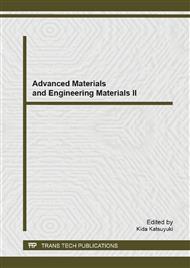[1]
N. Sombatsompop, R. Dangtangee. Effects of the actual diameters and diameter ratios of barrels and dies on the elastic swell and entrance pressure drop of natural rubber in capillary die flow, Journal of applied polymer science. 2002, 86 (2002).
DOI: 10.1002/app.11212
Google Scholar
[2]
H.W. Miillner, A. Wieczorek, and J. Eberhardsteiner. Numerical Prediction of the Dimensioning of Tools for the Extrusion Process of Rubber Profiles, AIP. 907 (2007) 986-994.
DOI: 10.1063/1.2729642
Google Scholar
[3]
J.J. del Coz Diaz , P.J. Garcia Nieto and J. Ordieres Mere, A. Bello Garci. Computer simulation of the laminar nozzle flow of a non-Newtonian fluid in a rubber extrusion process by the finite volume method and experimental comparison, Journal of Non-Crystalline Solids. 353 (2007).
DOI: 10.1016/j.jnoncrysol.2006.12.067
Google Scholar
[4]
Y. K. Dai, C. X. Zhou and W. Yu. Inverse Designing Simulation of Extrusion Die of Auto Rubber Seal and Verifications. Plastics, Rubber and Composites. 36 (2007) 141-148.
DOI: 10.1179/174328907x191404
Google Scholar
[5]
Y. K. Dai, H. Zheng, C. X. Zhou and W. Yu. Quick Profile Die Balancing of Automotive Rubber Seal Extrusion by CAE technology, J. Macromol. Sci, Part A: Pure and Applied Chemistry. 45 (2008) 1030-1038.
DOI: 10.1080/10601320802454581
Google Scholar
[6]
N. sombatsompop, A Survey of Rheological Properties of Polymer Melts in Capillary Rheometers, Progress in Rubber and Plastics Technology. 15(1999) 47-68.
Google Scholar
[7]
J. L. White, Yeh Wang, A. I. Isayev, etc. Modelling of Shear Viscosity Behavior and Extrusion through Dies for Rubber Compounds, Rubber Chemistry and Technology. 60 (1987) 337-360.
DOI: 10.5254/1.3536134
Google Scholar
[8]
Miguel A. López Manchado, Jerico Biagiotti and José M. Kenny. Rheological behavior and processability of polypropylene blends with rubber ethylene propylene diene terpolymer, Journal of Applied Polymer Science. 81 (2001) 1-10.
DOI: 10.1002/app.1407
Google Scholar
[9]
Y. Rubin, Th. Marchal, Rothemeyer. Louvain-la-Neuve and Hanover, Die Design Improvements through Numerical Simulation for the Extrusion of EPDM Compounds, Machinery and Equipment, 51 (1998) 602-608.
Google Scholar
[10]
Y.S. Ha, J.R. Cho, T.H. Kim and J.H. Kim. Finite element analysis of rubber extrusion forming process for automobile weather strip, Journal of materials processing technology. 201 (2008) 168-173.
DOI: 10.1016/j.jmatprotec.2007.11.290
Google Scholar


